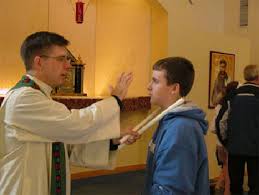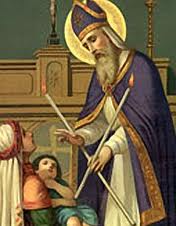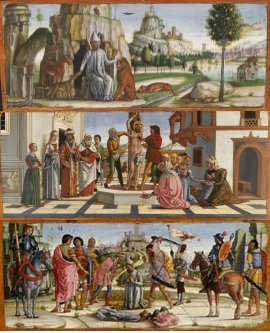
Summary: St Blaise, bishop, martyr. Blaise was a fourth century bishop at Sebaste (now the city of Sivas in central Turkey, in what was then the Roman province of Armenia-Cappadocia). During a persecution – probably ordered by Constantine’s ally and co-emperor Licinius – he was martyred in 316 AD. This much at least seems to be historical fact, according to the New Roman Martyrology 2004.
Patrick Duffy asks who was Blaise and why he became famous for blessing sore throats. He then outlines some of the practices associated with his cult and evaluates them in the light of the Vatican’s Directory on Popular Piety and the Liturgy .
 The ritual of the blessing of throats
The ritual of the blessing of throats
In many places on 3rd February – his feast day – people gather in churches for the blessing of throats. The blessing is a sign of the people’s faith in God’s protection and love for the sick.
Using two crossed and unlighted candles, the priest (or other minister) touches the throat of each person, saying:
‘Through the intercession of Saint Blaise, bishop and martyr, may God deliver you from all ailments of the throat and from every other evil: + in the name of the Father, and of the Son and of the Holy Spirit. Amen.’
Usually the blessing takes place during Mass. It follows the homily and the prayer of the faithful. If done outside of Mass, a brief celebration of the word of God with the scripture readings suggested in the Lectionary is recommended before the blessing is given.
 (In the Eastern churches his feast falls on the 11th February, in the West on 3rd February.)
(In the Eastern churches his feast falls on the 11th February, in the West on 3rd February.)
Stories about him in the martyrology accounts
In the Middle Ages Blaise became one of the most widely venerated saints in the Western Church even though he was from the East. Different accounts of his life and stories about him appear in the 9th century martyrologies and these give us a clue to the source of his popularity.
How has he become so famous for the blessing of throats? The most significant detail tells that when Blaise had been captured and was on his way to prison, a boy was brought to him in danger of choking from a fishbone stuck in his throat. Blaise prayed over him and he was cured. (Perhaps to fill out his healing credentials, it is also reported that before he was chosen as bishop, Blaise had practised as a physician!)
Another detail recounts that when the persecution began, Blaise withdrew from the city of Sebaste and lived in a cave in the wilderness where he befriended the birds and wild animals. He cared for them and they watched out for him. So we needn’t be surprised that he becomes a forerunner of St Francis as patron of all kinds of animals.
It is also reported that when he was arrested on orders of the local governor Agricolaus and again on his way to prison, a woman whose pig had been carried off by a wolf begged him to help her. He promised with a smile that her request would be granted. Shortly afterwards the wolf appeared at the woman’s door depositing the pig at her feet.
And finally about the manner of his death – it is told that he was first beaten, then put on the stone table used for combing out wool and flayed with the prickly metal combs that remove tiny stones from the wool. Finally he was put to death and beheaded.
 Veneration of the saint
Veneration of the saint
The wonder about St Blaise is how veneration of a martyred bishop in eastern Turkey spread so widely in the western world. His fame as a healer of sore throats is documented in the East from the 6th century and in the West by the 9th. But he also becomes a protector of cities, a protector against wild animals, a patron of veterinarians, wool-combers and of the woollen industry in general, as well a general benefactor or even a mascot of many rural and urban activities.
Dubrovnik
The maritime kingdom of Ragusa (present day Dubrovnik)was under threat of attack from the Venetians in the year 971. Blaise, we’re told, appeared in a vision to alert the inhabitants to the danger of the impending attack. Ever since Dubrovnik has honoured him as its city patron (Croatian Sveti Vlaho) and a statue of him holding a model of the city in his hand stands over the city’s entrance gate. And although the city’s cathedral is dedicated not to Sveti Vlaho but to Mary’s Assumption, the cathedral reliquary today has an almost unbelievable array of Blaise’s relics – his head, his right hand, his left hand, his throat and his right foot – all cased in gold and set on display. His own titular church stands a few yards across the square with his statue with a gold mitre atop the pediment.
Italy
There are many stories of devotion to Blaise in Italy and Sicily where he is known as San Biag(g)io. One tells that some Armenians who were bringing his relics to Rome were ship-wrecked and came ashore at Maratea on the south coast near Potenza in Lucania where there is an important church in his honour now overlooking the harbour. Another noteworthy church stands in the mountains of Tuscany just outside Montepulciano.
Also throughout Italy and Sicily San Biagio’s Feast is celebrated where wool is worked. Slices of panettone or little cakes are baked on the 1st and blessed and shared out on the 3rd February . In Serra San Bruno in Calabria, the cookie for San Biagio is called an abbacolo (Latin baculus = walking stick, staff) and is baked in the form of a question mark or bishop’s crosier. The young men of the town offer them to their sweethearts. If the girl breaks the piece in two and gives part back to the boy, keeping the other for herself, it means she will marry him!
Germany
Pope Leo IV is said to have presented relics of St Blaise (part of his head and arm bone) to Duke Wolfenus of Rheinau, Germany, while he was on pilgrimage in Rome in 855. He brought them home with him where they are said to have been the reason why a wandering Irish monk, Fintan from Leinster, came to visit the place. There is a nearby village of St Blasien in the Black Forest.
And in Germany, though nowhere else, perhaps because of similarity of the sound of his name, he is regarded as patron saint of wind instruments, bands and their players from the German word blasen “to blow”. Other relics of St Blaise are reported to be at Braunschvieg in Germany and Paris in France.
France
In many villages in southeast France from the middle ages a great carnival took place on St Blaise’s Day. Traditionally a blessing of corn seeds (benedictio seminum granarum) took place which though widespread is not found in the church’s official ritual books. The women would bring a pail of seeds to the church to be blessed. Half of the seed was left as an offering to the church, the other half taken home and mixed with the regular seed before plowing.
Another indication of his popularity comes from the town of Aubin near Villefranche. A 12th century church dedicated to Our Lady was enlarged in the 15th century with St Blaise taking over as titular and patron of the church and parish. This change in the dedication was not done by any act of episcopal authority and in 1915 the bishop decided to change back the church and parish to Our Lady of the Assumption.
Why did Blaise substitute Our Lady as patron? It seems he had a reputation for putting a stop to epidemics that wiped out cattle and that local clergy and people wanted to recognise his effective intercession. A statue of St Blaise still remains in the church.
Spain
Known in Spain as St Blas, his feast in many places combines a spring festival with the throat blessing.
Even today from 1st to 5th February the town of Bocairent near Valencia has a six-day festival that is a national tourist attraction. While honouring St Blas, it also embraces other themes. Daily routine is disrupted as the inhabitants put on festive attire (Moor or Christian robes) and there is general merriment for days. On 3rd February after what is called an early morning Diana, they attend Mass in festive costume and panellets (sweet breads) offered to St Blas are blessed and shared among family, friends and domestic animals.
The day of the 4th February hosts a Feast of the Moors and the Christians. Nine different fraternities, five Christian – españoletos, granaderos, contrabandistas, zuavos and estudiantes – and four from the Moorish side – viejos, marrocs, moros marinos and mosqueteros, parade in costume in the morning carrying various weapons or insignia. In the afternoon they engage in a mock battle during which there is a “reconquest” of the castle by the Christians. Finally there is a farcical fireworks display in which the mahoma – nothing to do with the prophet of Islam, they say(!), but a huge 4 metres high papier-maché figure – is filled with fireworks, blown-up and burnt. All go home in peace!
These celebrations are said to have began around 1632 when a terrible diphtheria epidemic in the town ended on praying to the saint. San Blas then became the new patron, substituting the previous patron, Sant Jaume. From Spain devotion to Blaise spread to the US and Latin America where there are many churches in his honour.
England
Blaise’s popularity in England is linked with his patronage of the guild of wool-combers and it seems likely also that this factor is the reason for the naming of the village and parish of St Blazey in Cornwall. There is even a tradition that Blaise landed in person at nearby Par Bay and taught the English the crafts of the woollen industry.
Every seventh year in Leeds and Bradford, the centres of the woollen industry in Yorkshire, and every year in Norwich, on 3rd February, “all those engaged in woollen manufacture celebrated the feast with great pomp and festivity” (Rev J Bartlett, Lecture on the history of the town of St Blazey, 1856).
.
The highlight of the celebration at Leeds was the recitation of the following lines in honour of the patron saint of wool-combers:
Hail to the day, whose kind suspictous (sic!) rays,
Deigned first to smile on famous Bishop Blaize,
To the great author of our combing trade,
This day’s devoted, and true honour paid;
To him whose fame through Britain’s Isle resounds,
To him whose goodness to the poor abounds,
Long shall his name in British annals shine
And grateful ages offer at his shrine.
By this, our trade are thousands daily fed,
By it supplied with means to earn their bread.
In various forms our trade its work imparts,
In different methods, and by different arts,
Preserve from starving, – indigents distrest,
As combers, spinners, weavers, and the rest.
Bonfires were also lit as part of the celebration – probably inspired by the sound of the English word blaze.
Evaluation
Some writers, like Seán Ó Duinn OSB in The rites of Brigid: goddess and saint (Veritas Dublin) 2005:29-30, point out that, like St Brigid, St Agnes and St Valentine at springtime and St Nicholas at Christmas, Blaise is one of those saints who tend to accumulate around their name legends and lore from traditional deities and folk customs. We have already seen how the sound of the saint’s name in English (Blaise) led to bonfires on his feast and in German to his becoming patron saint of bands with wind instruments (German blasen =to blow). Similar examples from France and Italy are the French word for wheat (blé) and the Italian word for crops (biade) leading to some of the “mother-goddess” themes that characterise Blaise’s feast in those countries. So also, as this is the time of the Celtic spring festival Imbolc (= in the belly) or, as it is also called, Oimelc (= feast of lactating ewes), it need not surprise us that legends about fertility and animals or sheep, wool and wool-combing grew up around Blaise.
General Church principles about popular Piety
In 2001 the Vatican Congregation for Divine Worship and the Discipline of the Sacraments issued a Directory on Popular Piety and the Liturgy giving principles and guidelines for evaluating the popular piety that surrounds saints like Blaise. By popular piety it designates those devotional practices that are inspired not by the liturgy but by forms derived from a particular people, nation or culture.
In the section on saints, the Directory points out that the Church honours saints because “in their lives they have achieved the paschal mystery as Christ did in his” (209) and goes on to cite the words the priest says at Mass in the Preface for Holy Men and Women:
In their lives on earth you give us an example;
In our communion with them you give us their friendship;
In their prayer for the church you give us strength and protection.
It accepts (par 11) that saints can be
It openly acknowledges the positive anthropological, social and religious significance of a saint’s feast day, but it also cautions against it becoming an occasion of “ambiguous amusement leading to new forms of enslavement” (232-3).
About relics, it asks that their authenticity should be ensured and urges that every temptation to multiply them or give them an importance that might lead to superstition be resisted (237).
It allows that legends of their thaumaturgic powers can accrue to saints, but primary place, it says, must be given to their effective Christian witness and the manner in which their charism has enriched the Church (231).
Applying this to the different manifestations of the cult of St Blaise, we can say the Church’s attitude is one of cautious affirmation of the themes of popular piety.
_______-______________________________
******************************
Memorable Wise Words for today
God resists the proud
whether they are covered with silk or with rags.
But he gives grace to the humble,
whether or not they have possessions in this world
God looks at what is within,
It is there he assesses, there he examines
~St Augustine ~
**********************************